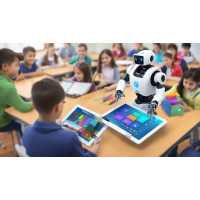Mastering Autonomous Learning: Building an AI That Teaches Itself

Key Takeaways:
- Understand the basics of artificial intelligence and machine learning.
- Recognize the importance and potential of self teaching AI in various fields.
- Learn about the essential components and architecture required to build a self teaching AI system.
- Discover techniques for collecting and preparing high-quality datasets for training your self teaching AI model.
- Explore methodologies for training, fine-tuning, evaluating, and testing your self teaching AI model.
Understanding Artificial Intelligence and Machine Learning
Before embarking on your journey to create a self teaching AI, it's important to grasp the fundamental concepts of artificial intelligence (AI), machine learning, and deep learning. These technologies have revolutionized various industries and are at the forefront of cutting-edge innovation.
Artificial intelligence refers to the development of computer systems that can perform tasks that typically require human intelligence. This includes problem-solving, decision-making, and learning from experience. Machine learning, on the other hand, is a subset of AI that focuses on enabling computers to learn from data without explicit programming. It involves the development of algorithms that can identify patterns and make predictions based on available information.
Deep learning is a specialized branch of machine learning that is inspired by the structure and function of the human brain. It uses artificial neural networks, which are modeled after the neurons in our brains, to process and analyze large amounts of data. Deep learning algorithms have the ability to learn and extract intricate patterns, making them particularly powerful in tasks such as image and speech recognition.
Understanding these concepts is essential as they form the basis of self teaching AI. By leveraging machine learning and deep learning techniques, self teaching AI systems can continuously learn and improve from their own experiences, making them adaptable and autonomous in their decision-making processes.
| Key Concepts | Definition |
|---|---|
| Artificial Intelligence | The development of computer systems that can perform tasks requiring human intelligence. |
| Machine Learning | A subset of AI that enables computers to learn from data without explicit programming. |
| Deep Learning | A specialized branch of machine learning that uses artificial neural networks to analyze and process data. |
| Self Teaching AI | AI systems that can continuously learn and improve from their own experiences. |
The Importance of Self Teaching AI
Self teaching AI has the potential to revolutionize industries by enabling machines to learn from data and improve their performance without human intervention. With the rapid advancements in artificial intelligence and machine learning, self teaching AI has become a powerful tool for automating complex tasks and decision-making processes. By allowing machines to continuously learn from new data and adapt their behavior accordingly, self teaching AI can provide valuable insights and solutions across various domains.
One of the key advantages of self teaching AI is its ability to autonomously learn and improve over time. Traditional AI systems require explicit programming and constant human supervision, limiting their scalability and adaptability. In contrast, self teaching AI can analyze vast amounts of data, identify patterns, and adjust its algorithms to optimize performance. This enables it to tackle evolving challenges and make accurate predictions, making it highly valuable in fields such as healthcare, finance, and transportation.
In addition, self teaching AI can significantly enhance the efficiency and productivity of organizations. By automating repetitive tasks, self teaching AI frees up human resources, enabling professionals to focus on more complex and strategic activities. It can also provide valuable recommendations and insights based on its continuous learning, helping businesses make data-driven decisions and improve their operations. Ultimately, self teaching AI empowers organizations to leverage the power of machine learning algorithms to gain a competitive edge and drive innovation.
Challenges and Considerations
However, it is important to note that implementing self teaching AI is not without challenges. Developing an effective self teaching AI system requires careful consideration of various factors, such as data quality, algorithm selection, and ethical considerations. It is crucial to ensure that the data used for training the AI model is diverse, representative, and free from biases. Additionally, ongoing monitoring and evaluation are essential to address any potential issues or biases that may arise during the self teaching process.
In conclusion, self teaching AI holds immense potential for transforming industries and driving innovation. By allowing machines to learn autonomously, organizations can benefit from improved efficiency, accuracy, and decision-making capabilities. However, it is important to approach the development and implementation of self teaching AI with careful consideration and ethical considerations to ensure its effectiveness and reliability.
| Advantages of Self Teaching AI | Challenges of Self Teaching AI |
|---|---|
|
|
Components and Architecture of Self Teaching AI
Building a self teaching AI involves integrating key components such as data collection, neural networks, and reinforcement learning algorithms into a cohesive architecture. These components work together to enable the AI system to learn, adapt, and make intelligent decisions. Let's explore each component in detail:
Data Collection
Data collection is the foundation of building a self teaching AI. It involves gathering relevant and diverse datasets that will be used to train the AI model. The quality and quantity of the data are crucial for the success of the AI system. It is important to ensure that the collected data is representative of the real-world scenarios the AI model will encounter. This can be achieved through various methods such as web scraping, data labeling, or using existing public datasets.
Neural Networks
Neural networks are the core of AI systems, mimicking the human brain's ability to learn and process information. These networks consist of interconnected nodes (neurons) that process and transmit data. For self teaching AI, deep neural networks are commonly used due to their ability to handle complex patterns and relationships in the data. Training neural networks involves optimizing the weights and biases of the nodes through a process called backpropagation, where the AI model learns from its mistakes and adjusts its behavior accordingly.
Reinforcement Learning Algorithms
Reinforcement learning algorithms play a vital role in self teaching AI, as they enable the system to learn and improve through trial and error. These algorithms use a reward-based system, where the AI model receives positive reinforcement for making correct decisions and negative reinforcement for incorrect decisions. Over time, the AI system learns to maximize the rewards and minimize the penalties, leading to improved performance and decision-making capabilities.
Table 1: Components of Self Teaching AI
| Component | Description |
|---|---|
| Data Collection | Gathering relevant and diverse datasets for training |
| Neural Networks | Mimicking the human brain's ability to learn and process information |
| Reinforcement Learning Algorithms | Enabling the system to learn and improve through trial and error |
By integrating these components into a well-designed architecture, developers can build a powerful self teaching AI system that can learn and adapt autonomously. However, it is important to note that building a self teaching AI is a complex process that requires expertise in AI development, machine learning, and deep learning. It requires careful consideration of the data collection methods, neural network architecture, and reinforcement learning algorithms to ensure the AI system's effectiveness and reliability.
Data Collection and Dataset Preparation
Collecting and curating a diverse and representative dataset is crucial for training a self teaching AI model that can generalize and learn from various scenarios. To build a robust self teaching AI, you need to gather relevant data from a wide range of sources, ensuring it covers different aspects and perspectives. The dataset should include examples that encapsulate the challenges your AI system will encounter in real-world applications.
When collecting data, it is important to consider the quality, relevance, and quantity of the samples. The dataset should be well-balanced, encompassing various categories and scenarios to avoid biases and ensure fair representation. Additionally, it is crucial to annotate the data accurately, providing clear labels and metadata that will assist the AI model in understanding and learning from the examples.
Once you have collected the data, the next step is to prepare it for training. This involves cleaning the dataset by removing any duplicate or irrelevant samples, as well as addressing any biases or inconsistencies. You can also augment the dataset by introducing variations and perturbations to enhance the model's ability to generalize and adapt to different situations.
Table: Steps for Dataset Preparation
| Step | Description |
|---|---|
| 1 | Collect diverse and representative data |
| 2 | Annotate the data with clear labels and metadata |
| 3 | Clean the dataset by removing duplicates and irrelevant samples |
| 4 | Address biases and inconsistencies in the dataset |
| 5 | Augment the dataset with variations and perturbations |
By following these steps, you can ensure that your self teaching AI model is equipped with a high-quality dataset that allows it to learn, adapt, and make informed decisions in real-world scenarios. Remember, the success of your AI system heavily relies on the quality and diversity of the data it learns from.
Training and Fine-Tuning Your Self Teaching AI Model
Once you have your dataset ready, it's time to train and fine-tune your self teaching AI model using powerful machine learning algorithms. This crucial step plays a vital role in ensuring the effectiveness and accuracy of your AI system. By training your model, you enable it to learn from the data and make intelligent predictions or decisions.
To begin, you will feed your dataset into the AI model and allow it to analyze and extract patterns from the data. This process involves adjusting the model's parameters and optimizing its architecture to achieve the desired performance. You may experiment with different algorithms, such as neural networks or reinforcement learning, to enhance the model's learning capabilities.
During the training phase, it is important to monitor the model's progress and evaluate its performance regularly. You can use various evaluation metrics, such as accuracy or loss functions, to assess how well the model is learning and adjusting to the data. Fine-tuning comes into play when you fine-tune the model's parameters based on the evaluation results, making incremental adjustments to optimize its performance.
Hyperparameter Tuning and Regularization Techniques
When training your self teaching AI model, you may also need to consider hyperparameter tuning and regularization techniques. Hyperparameters are parameters that govern the learning process, such as learning rate or batch size. Finding the optimal values for these hyperparameters can significantly impact the model's performance. Regularization techniques, such as dropout or weight decay, help prevent overfitting, where the model becomes too specialized in the training data and fails to generalize to new data.
Throughout the training and fine-tuning process, it is essential to have a comprehensive understanding of the underlying algorithms and their capabilities. Experimenting with different architectures and techniques can lead to improved results. Remember, training an AI model is an iterative process, and continuous refinement and experimentation will be key to achieving the best possible performance.
| Training and Fine-Tuning Tips |
|---|
| 1. Start with small, manageable datasets to test and iterate quickly. |
| 2. Experiment with different algorithms, architectures, and hyperparameters to find the best combination for your specific task. |
| 3. Regularly evaluate your model's performance using appropriate metrics and adjust accordingly. |
| 4. Keep up with the latest research and advancements in the field to stay informed about new techniques and approaches. |
Evaluating and Testing Your Self Teaching AI Model
Evaluating and testing your self teaching AI model is essential to ensure it meets the desired performance criteria and can adapt to different scenarios. Proper evaluation allows you to identify any weaknesses or limitations in your model, and testing helps validate its effectiveness in real-world applications. Here are some key steps to consider when evaluating and testing your self teaching AI:
- Define performance metrics: Before testing your self teaching AI model, it's crucial to establish clear and objective performance metrics. These metrics will help you measure the accuracy, efficiency, and adaptability of your model. Consider metrics such as precision, recall, F1 score, and overall prediction accuracy.
- Create a diverse test dataset: To ensure the robustness of your self teaching AI model, it's important to test it with a diverse dataset that represents the real-world scenarios you want it to handle. Include both positive and negative examples, and consider edge cases to evaluate the model's ability to handle unexpected situations.
- Perform cross-validation: Cross-validation is a technique used to assess the model's performance across multiple iterations of training and testing. By dividing your dataset into multiple folds and training/testing the model on different combinations, you can obtain a more reliable evaluation of its performance.
- Iterate and refine: Evaluating and testing your self teaching AI model should be an iterative process. Analyze the results, identify areas of improvement, and refine your model accordingly. This ongoing refinement will help you achieve better performance and ensure your model remains adaptable to evolving scenarios.
"Proper evaluation allows you to identify any weaknesses or limitations in your model, and testing helps validate its effectiveness in real-world applications."
Table 1: Performance Metrics for Evaluating Self Teaching AI Model
| Metric | Description |
|---|---|
| Precision | The ratio of true positive predictions to the total predicted positives, measuring the ability to avoid false positives. |
| Recall (Sensitivity) | The ratio of true positive predictions to the total actual positives, measuring the ability to detect all relevant instances. |
| F1 Score | The harmonic mean of precision and recall, providing a balanced measure of both metrics. |
| Overall Prediction Accuracy | The percentage of correct predictions over the total predictions made. |
Evaluating and testing your self teaching AI model is a critical step in its development. By following these guidelines and utilizing appropriate performance metrics, you can ensure that your model meets the desired criteria and performs effectively in real-world applications.
Deploying and Scaling Your Self-Teaching AI
Once you have successfully developed your self-teaching AI model, the next step is to deploy and scale it for practical use, ensuring it can handle increasing demands. Deploying your AI system involves making it accessible and operational, while scaling involves expanding its capacity to accommodate larger workloads.
Deploying Your Self-Teaching AI
To deploy your self-teaching AI, you will need to consider the infrastructure and environment in which it will run. This includes choosing the right hardware and software resources, such as powerful processors, memory, and storage, to support the computational requirements of your AI model. You may also need to configure networking settings and security protocols to protect sensitive data.
One common method of deployment is using cloud-based platforms, which offer scalability, flexibility, and cost-effectiveness. Cloud services allow you to easily provision and manage resources, making it convenient to deploy your AI system across multiple locations or serve a large user base. Popular cloud providers for AI deployments include Amazon Web Services (AWS), Google Cloud Platform (GCP), and Microsoft Azure.
Scaling Your Self-Teaching AI
As your AI system gains traction and more users interact with it, scaling becomes crucial to ensure optimal performance. Scaling can involve vertical scaling, where you upgrade the hardware resources of your AI system, or horizontal scaling, where you distribute the workload across multiple instances.
Vertical scaling typically involves upgrading your hardware infrastructure, such as increasing the CPU and memory capacities of your servers. This approach allows your AI system to handle more complex tasks and heavier workloads. However, there may be limitations to vertical scaling, as hardware upgrades can be costly and may not provide unlimited scalability.
On the other hand, horizontal scaling involves distributing the workload across multiple instances or servers. This approach allows you to handle increasing demands by adding more computing resources in a cost-effective way. Load balancing techniques, such as round-robin or dynamic load balancing, can be applied to evenly distribute incoming requests among the instances, ensuring efficient resource utilization.
Summary
Deploying and scaling your self-teaching AI model are crucial steps in bringing your AI system into practical use. Consider the infrastructure and environment for deployment, whether it's on-premises or utilizing cloud-based platforms. Scaling can be achieved through vertical scaling, upgrading hardware resources, or horizontal scaling, distributing the workload across multiple instances. By deploying and scaling your self-teaching AI effectively, you can enable its use in real-world applications and ensure it can handle increasing demands.
| Key Points | Takeaways |
|---|---|
| Deploying your self-teaching AI | Consider infrastructure and cloud-based platforms |
| Scaling your self-teaching AI | Vertical scaling and horizontal scaling |
| Importance of deployment and scaling | Enables practical use and handles increasing demands |
Challenging and Expanding the Capabilities of Your Self Teaching AI
To unlock the true potential of your self teaching AI, it's important to constantly challenge and expand its capabilities, pushing the boundaries of what it can achieve. By doing so, you can ensure that your AI system continues to learn and adapt in a dynamic and evolving environment.
One effective way to challenge your self teaching AI is through the use of complex tasks and real-world scenarios. By exposing your AI system to a diverse range of challenges, you can encourage it to develop advanced problem-solving skills and overcome obstacles that it may encounter in practical applications.
In addition to challenging your self teaching AI, it's crucial to continuously expand its capabilities by introducing new data and training methodologies. By providing your AI system with a wider variety of information, you can enhance its ability to learn and make accurate predictions.
Exploring New Training Techniques and Algorithms
To expand the capabilities of your self teaching AI, consider exploring new training techniques and algorithms. This could involve experimenting with different neural network architectures, reinforcement learning algorithms, or even incorporating cutting-edge developments in the field of artificial intelligence.
Furthermore, it's important to stay updated on the latest research and advancements in AI. By staying informed, you can leverage new breakthroughs to enhance the performance and capabilities of your self teaching AI.
| Benefits of Challenging and Expanding | New Training Techniques and Algorithms |
|---|---|
|
|
In summary, challenging and expanding the capabilities of your self teaching AI is crucial for maximizing its potential. By exposing it to complex tasks, introducing new data, and exploring innovative training techniques, you can ensure that your AI system remains at the forefront of technological advancements and continues to deliver exceptional performance.
Conclusion
Congratulations on gaining a deep understanding of how to create a self-teaching AI and the exciting possibilities it holds! With the knowledge and tools provided in this article, you are now ready to dive into the world of artificial intelligence and bring your own self-teaching AI to life.
In this comprehensive guide, we explored the basics of artificial intelligence, machine learning, and deep learning, laying a solid foundation for your AI development journey. We highlighted the importance of self-teaching AI and its potential for autonomous learning and adaptation in various industries.
We discussed the essential components and architecture required to build a self-teaching AI system, including data collection, neural networks, and reinforcement learning algorithms. We guided you through the process of collecting relevant data and preparing a high-quality dataset for training your AI model.
Furthermore, we explored the techniques and methodologies involved in training and fine-tuning your self-teaching AI model using machine learning algorithms. We discussed methods for evaluating and testing the performance of your AI model, ensuring its effectiveness and reliability. We also addressed considerations and strategies for deploying and scaling your self-teaching AI system, enabling it to handle real-world applications efficiently.
Lastly, we explored ways to challenge and expand the capabilities of your self-teaching AI, empowering it to tackle complex tasks and continue learning autonomously. As you embark on your AI journey, remember the importance of continuous learning and staying updated with the latest advancements in the field of artificial intelligence.
With determination and perseverance, you have the potential to create groundbreaking self-teaching AI systems that can revolutionize industries and positively impact society. Good luck on your AI development endeavors!
FAQ
Q: Why are GPT detectors unreliable in identifying AI-generated text?
A: GPT detectors often falsely label articles written by non-native English speakers as AI-created due to their poor performance in evaluating text perplexity.
Q: What are the negative implications of unreliable GPT detectors?
A: The poor performance of GPT detectors can impact job applications, college entrance essays, and student assignments in academic and professional settings.
Q: Why are non-native English speakers more likely to be flagged as AI-generated?
A: GPT detectors evaluate text perplexity, which means that essays with simpler word choices used by non-native English speakers are more likely to be flagged as AI-generated.
Q: How can the detectors be fooled with minimal prompt design?
A: The detectors can be easily fooled by manipulating the prompt design, which raises concerns about their reliability and effectiveness.
Q: What can educators and employers do to avoid relying on these detectors?
A: Educators and employers should be cautious and avoid relying solely on GPT detectors, considering their unreliability and potential negative implications.
Q: What needs to be done to improve the algorithms used in GPT detectors?
A: The algorithms used in GPT detectors should be further improved and evaluated before being implemented, potentially by training them with more diverse types of writing.
Source Links
Tags: AI tools
Related Articles
AI tools for Teachers
Discover the top 7 AI tools for teachers in 2023, enhancing teaching methods and boosting student engagement. Maximize your teaching potential today!
Read MoreAI as a Learning tool
Delve into how AI can be used as a tool for learning in modern education. Explore AI's impact on learning techniques and progressive strategies in the US.
Read MoreHow is AI Useful for Kids?
Discover how AI is useful for kids. Dive into the numerous benefits and impacts of AI on child development, education, and more. Explore with us today.
Read MoreUnraveling the Puzzle: How do you use AI tools in the classroom?
Unlock the power of AI in education! Discover innovative ways to integrate artificial intelligence tools into your classroom, enhancing learning experiences.
Read MoreUsing AI to Create Engaging Presentations
Learn how to use AI technology to create compelling and engaging presentations quickly and easily.
Read More




